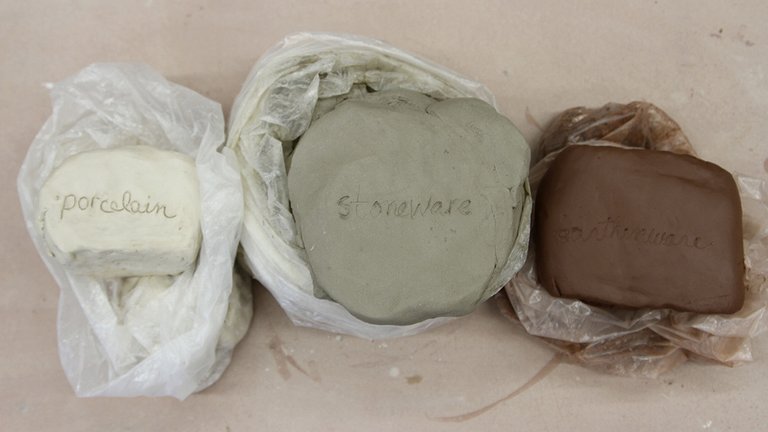There are dozens of types of clay. In pottery they can be divided into three basic classes: earthenware clay, mid-fire stoneware clay and high-fire stoneware clay. So in short, the three classes are earthenware, stoneware and porcelain.

The three categories are based on the duration and temperature in which firing takes place in order to reach optimal hardness. Earthenware clay is the hardiest, followed by stoneware which has basic workability, then comes porcelain which is the most delicate; delicacy is the result of lack of impurities.
Porcelain clays have the highest firing temperature. They are characteristically whiter shades as they are made of fine-grained white clays with high contents of kaolin. Stoneware clays fire at a medium temperature, they are very durable and non-porous; they are generally shades of brown or gray due to low levels of impurities. Earthenware has the lowest firing temperatures; these clays are the classic terra cotta commonly seen. Earthenware is also really cool because it can be fired without a kiln - just in your backyard if done successfully. This is why most ancient pottery is earthenware.
The piece above is porcelain.
Cool. Thanks for the info. 3 is a great number. Have you worked with all 3?
Yes lol.
Wow. Which do you prefer?
I am not a fan of earthenware. It is generally grainy. If I'm making something large, stoneware is nice because it is more forgiving than porcelain. But, porcelain is where it's at.
Eye seeeeee...... ....excellent... what type of paint do you cover it with that can withstand that incredibly hot hot heat?
Glaze is crazy, it is very unforgiving and unpredictable. Technically you could try firing any glaze at any temperature. There are underglazes, which can be applied during the first initial bisque fire. Underglazes leave only color/design, and no shine. Then there are overglaze colors (shiny) which are generally low temperature glazes. High temperature glazes fired between 1200 and 1400 °C (porcelain). Medium temperature glazes are fired at 1000–1050 °C (earthenware). Low temperatures require the use of boron containing materials in order to produce a melted glass. Low fire glazes are not as hard as well formulated medium temperature glazes, however they are available in a much wider range or colors.
You know a lot about ceramics! Thank you for the information! Psy would love to see more in the future! What type of stuff do you prefer to make?